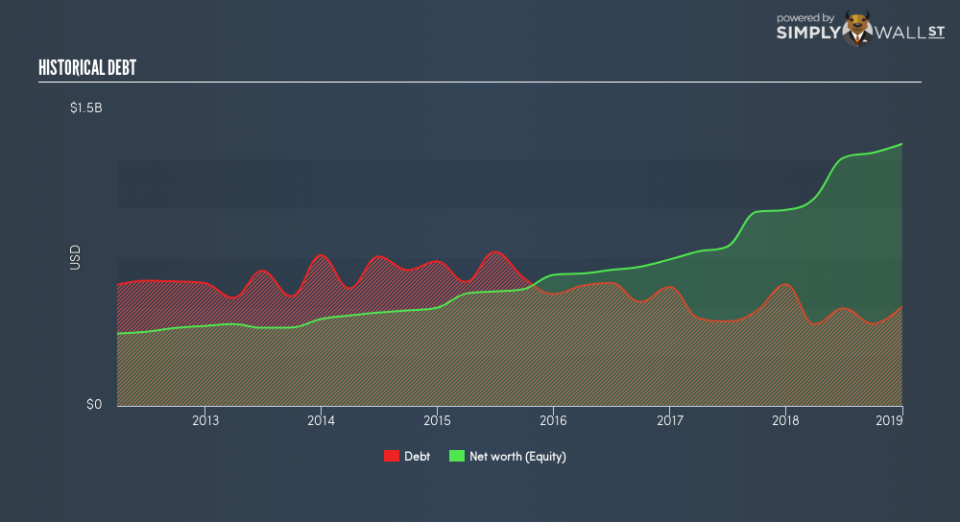Are You Considering All The Risks For Heartland Financial USA, Inc.’s (NASDAQ:HTLF)?

Want to participate in a short research study? Help shape the future of investing tools and receive a $20 prize!
The banking sector has been experiencing growth as a result of improving credit quality from post-GFC recovery. Heartland Financial USA, Inc. (NASDAQ:HTLF) is a small-cap bank with a market capitalisation of US$1.7b. Its profit and value are directly impacted by its borrowers’ ability to pay which is driven by the level of economic growth. This is because growth determines the stability of a borrower’s salary as well as the level of interest rates. Risk associated with repayment is measured by bad debt which is written off as an expense, impacting Heartland Financial USA’s bottom line. Today we will analyse Heartland Financial USA’s level of bad debt and liabilities in order to understand the risk involved with investing in the bank.
View our latest analysis for Heartland Financial USA
Does Heartland Financial USA Understand Its Own Risks?
Heartland Financial USA’s understanding of its risk level can be estimated by its ability to forecast and provision for its bad loans. If it writes off more than 100% of the bad debt it provisioned for, then it has inadequately estimated the factors that may have added to a higher bad loan level which begs the question – does Heartland Financial USA understand its own risk? Heartland Financial USA’s low bad loan to bad debt ratio of 85.27% means the bank has under-provisioned by -14.73%, indicating either an unexpected one-off occurence with defaults or poor bad debt provisioning.
What Is An Appropriate Level Of Risk?
By nature, Heartland Financial USA is exposed to risky assets by lending to borrowers who may not be able to repay their loans. Loans that cannot be recuperated by the bank, also known as bad loans, should typically form less than 3% of its total loans. When these loans are not repaid, they are written off as expenses which comes directly out of the bank’s profit. A ratio of 0.98% indicates the bank faces relatively low chance of default and exhibits strong bad debt management.
Is There Enough Safe Form Of Borrowing?


Heartland Financial USA makes money by lending out its various forms of borrowings. Deposits from customers tend to bear the lowest risk given the relatively stable amount available and interest rate. Generally, the higher level of deposits a bank retains, the less risky it is deemed to be. Heartland Financial USA’s total deposit level of 93% of its total liabilities is very high and is well-above the sensible level of 50% for financial institutions. This may mean the bank is too cautious with its level of its safer form of borrowing and has plenty of headroom to take on risker forms of liability.
Next Steps:
HTLF’s acquisition will impact the business moving forward. Keep an eye on how this decision plays out in the future, especially on its financial health and earnings growth. The list below is my go-to checks for HTLF. I use Simply Wall St’s platform to keep informed about any changes in the company and market sentiment, and also use their data as the basis for my articles.
Future Outlook: What are well-informed industry analysts predicting for HTLF’s future growth? Take a look at our free research report of analyst consensus for HTLF’s outlook.
Valuation: What is HTLF worth today? Has the future growth potential already been factored into the price? The intrinsic value infographic in our free research report helps visualize whether HTLF is currently mispriced by the market.
Other High-Performing Stocks: Are there other stocks that provide better prospects with proven track records? Explore our free list of these great stocks here.
We aim to bring you long-term focused research analysis driven by fundamental data. Note that our analysis may not factor in the latest price-sensitive company announcements or qualitative material.
If you spot an error that warrants correction, please contact the editor at editorial-team@simplywallst.com. This article by Simply Wall St is general in nature. It does not constitute a recommendation to buy or sell any stock, and does not take account of your objectives, or your financial situation. Simply Wall St has no position in the stocks mentioned. On rare occasion, data errors may occur. Thank you for reading.

